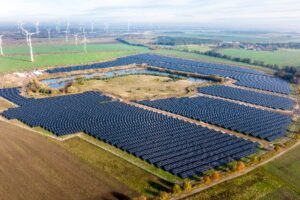Biofuels Definition

Biofuels refer today to liquid fuels such as ethanol and biodiesel that are used together or as replacement to regular fuels like gasoline, diesel and jet fuel.
Ethanol is an alcohol obtain through fermentation and can be used as replacement for or additive to gasoline, to improve the performance of the vehicle and lower the emissions.
Biodiesel is obtained from natural oils extracted from plants and seeds, and can be used in diesel engines as a replacement or blended with diesel fuel.
What Are Biofuels? – Definition
Biofuels are combustible fuels produced from biomass that can be used blended with transportation fuels like gasoline, diesel and kerosene or as a greener alternative to these fuels in order to lower the emissions.
Being produced from plants (energy crops), wood waste, agricultural waste, commercial, domestic, and even industrial waste, biofuels can be replenished much faster than fossil fuels such as oil because they only need years to regrow, instead of millions of years.
Domestic, commercial and industrial waste is produced every day, which means that we always have the necessary resources to produce biofuels.
Being replenished in a short amount of time, the waste and the biomass required to produce biofuels is considered a renewable resource.
If the resource if renewable, it also means that the biofuels are considered renewable energy sources.
Types of Biofuels
Today, there are four categories of biofuels based on the type of feedstocks used to produce them.
1. First-generation biofuels
First-generation biofuels (also named conventional biofuels) are produced from food crops grown on agricultural land.
Ethanol is produced from feedstocks that include sugar cane, corn, maize and other crops containing sugars.
To produce the alcohol called ethanol, the plant biomass needs to be fermented, distilled and dehydrated.
For biodiesel, feedstocks include naturally-occurring vegetable oils such as soybean and canola.
To produce biodiesel, we need to turn the vegetable oil into biodiesel through a process called transesterification.
2. Second-generation biofuels
Second-generation biofuels are produced from cellulosic materials (woody crops), wood grasses, agricultural waste or waste plant materials such as food crops that have already fulfilled their purpose as food.
To obtain second-generation biofuels, we use feedstocks growing on agricultural lands, but they are grown as byproducts of the main crop, or they grow on arable lands that are not suited to effectively grow food crops.
We also use woody crops, wood grasses (jatropha and other seed crops), agricultural waste (straw) and domestic waste such as used vegetable oil, and also municipal solid waste.
Wood waste is the main source of biomass
Second-generation biofuels are generally produced from cellulosic biomass (wood waste) and also domestic and municipal organic waste.
Due to the presence of the wood, lignocellulosic biomass can be turned into biofuels using a pretreatment before the fermentation process.
The used cooking oil needs to be refined through a process called transesterification to become hydrotreated vegetable oil (HVO).
HVO is used as fuel for large cargo ships to reduce the level of carbon emissions and particulate matter released by these ships.
HVO is also used to power buses and vehicles with diesel engines.
3. Third-generation biofuels
Third-generation biofuels are produced using the lipid production of algae.
Algae that have a content of natural oil higher than 50 percent are suited for the production of biofuels such as ethanol.
Producing biofuels from algae involves cultivating and harvesting the tiny microorganisms, putting them into an energy-intensive process to squeeze the lipids produced by the algae, and then refining the oil to produce biofuels.
Growing algae for biofuels in outside ponds is not secure because these tiny organisms are getting invaded by different predators, which severely affects the algae production.
However, some modern research has managed to fix the issue by keeping the algae production away from the outside invaders (growing algae in an artificial environment).
4. Fourth-generation biofuels
Fourth-generation biofuels refer to the biofuels that do not consume biomass in their production process.
We have here photobiological solar fuels and electrofuels.
Photobiological solar fuels refer to synthetic chemical fuels produced using the sunlight directly or indirectly to power a photochemical, photobiological, thermochemical and electrochemical reaction.
Electrofuels are also synthetic fuels that refer to an emerging class of carbon-neutral fuels used to store electrical energy produced by renewable resources in the chemical bonds of gas or liquid fuels.
Advanced Biofuels
Advanced biofuels is a term used to describe the new technological field of biofuel production that rely on garbage, animal fats and used cooking oils as feedstocks.
Advanced biofuels do not rely on biomass grown on agricultural land, so they don’t compete with food production.
Using Biofuels On A Mass Scale
Over the last decades, billions of dollars have been invested into biofuel research because we all need fuels that are cleaner and friendlier to the environment.
In order to make the hole process carbon neutral, the gases released when we burn biofuels need to be equivalent to the emissions that are absorbed by growing the biomass used as feedstock for biofuel production.
Being a renewable energy source, biofuels have become very useful for mankind in its fight against emissions that are producing climate change.
The first problem appeared when we realized that more resources are used to produce ethanol and biodiesel than the resources required to produce fossil fuels like gasoline and diesel fuel.
Ethanol uses food crops as feedstock
More than that, ethanol, which is a first-generation biofuel, requires food crops as feedstock, which competes with food production.
Besides competing with food production, growing the crop itself (corn in the United States), requires intensive resources such as land, water, energy and fertilizers (which pollute).
After growing the crop, we need to process the raw material into fuel, which consumes additional resources and makes the biofuel obtained (ethanol) more expensive than gasoline.
Creating ethanol being so resource-intensive, these cleaner fuels can actually end up producing even more emissions throughout their life cycle than fossil fuels.
In addition to this issue, ethanol can’t be used directly in our cars, it is used blended with gasoline.
Second-generation biofuels have overcome some of the issues produced by the first-generation biofuels by using cellulosic material and the denser, inedible parts of the crops.
Biofuels production shouldn’t compete with food production
Producing the wood-based feedstock does not compete with food production and this way the biofuel production consumes less energy.
However, the distillation process is expensive, so producing biofuels from cellulosic material will again consume more energy.
Biofuels are also produced from algae, which requires an energy-intensive process to squeezes the lipids out of the algae.
The extracted oils need to be refined before being turned into fuel.
Using algae, we have the same issues in creating cleaner and less expensive biofuels (compared to gasoline and diesel fuel) as we have in the case of ethanol due to the large number of resources involved in the production process.
When we rely on used vegetable oil to produce biodiesel, we only need to refine it using the process called transesterification and we get hydrotreated vegetable oil (HVO). The refining process also makes the biofuel obtained more expensive than regular diesel fuel.
Final conclusion
The solution in the case of biofuels seems to be provided by science.
Researchers are genetically modifying plants today to make them produce more fatty oil (which is used to make the biofuel), and this could allow us to get a higher energy yield from the resources invested into cultivating those organisms.
The market is already shifting to electric vehicles, but biofuels will still be used to power big container ships and even airplanes.







